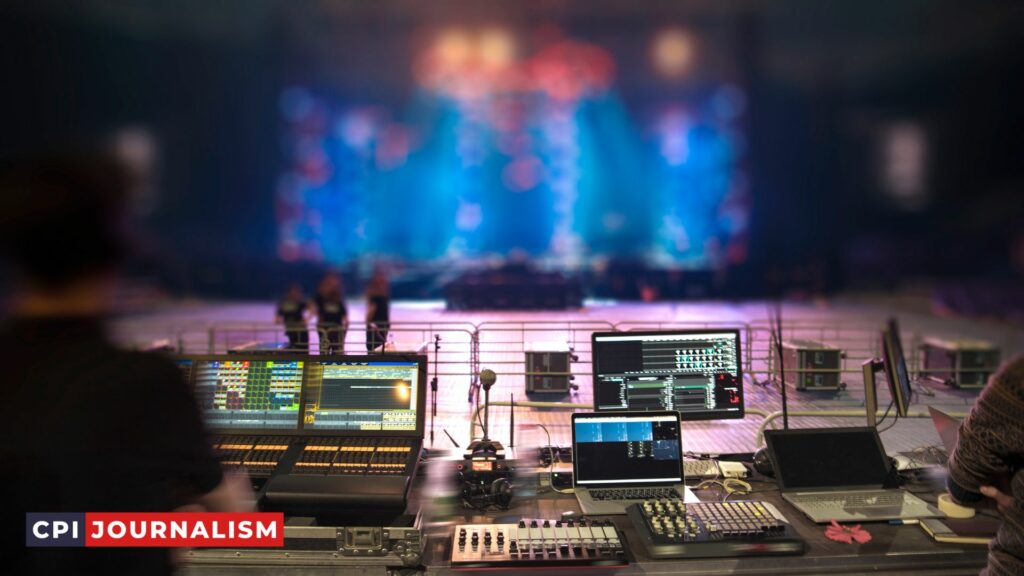What Is Broadcast Journalism? What Do They Do Exactly?
Broadcast journalism is a communication medium that many people use without even realizing it. Local newscasters keep us informed about the day’s events, traffic reporters tell us when we’re going to be late, and sports announcers keep us up to date on our favorite teams.
Broadcast journalism, also called electronic journalism, is the process of gathering and distributing information via radio and television.
These mediums are used to transmit news, traffic reports, sports scores, and more. Broadcast journalism is a career that lets you inform the public every day.
If you’re interested in becoming a broadcast journalist, or you want a better idea of what this career is all about, keep reading to learn more about the basics of this field.
What is Broadcast Journalism (Definition)?
Broadcast journalism is a type of journalism where the news is broadcasted on television or radio. Broadcast journalists are the ones who report the news on these platforms.
Broadcast journalism has evolved over the years. In the early days of television and radio, broadcast news was mostly about reporting the facts. But as the mediums have evolved, broadcast journalism has become more about storytelling.
Today, broadcast journalists are expected to not only report the news, but also to provide context and analysis. They are also expected to be able to tell a story in an engaging way.
Broadcast journalism is a demanding field. Broadcast journalists have to be able to think on their feet and be able to adapt to changing circumstances. They also have to be able to work under pressure.
If you’re thinking of becoming a broadcast journalist, you should be prepared to work hard and face challenges. But if you’re up for the challenge, it can be a very rewarding career.
What is the Work of a Broadcast Journalist?
A broadcast journalist is someone who gathers news stories and then presents them on television or radio.
They may work for a news organization, or they may be freelance. Broadcast journalists need to be able to find stories that will interest their audience, and then present them in an engaging way.
Broadcast journalists typically have a degree in journalism or communications. They may also have experience working in newsrooms. Some broadcast journalists start out working as interns or production assistants.
Broadcast journalists typically work long hours, and they may have to work on weekends or holidays. They may also have to travel to different locations to cover stories.
If you want to become a broadcast journalist, you should be prepared to work hard and be flexible with your schedule. You should also be comfortable with public speaking and be able to think on your feet.
Why is Broadcast Journalism Important?
Broadcast journalism is an important part of the news industry because it allows news to be delivered to a large audience quickly and efficiently. Broadcast journalists are able to reach a large number of people with their reporting, which is especially important in times of crisis or breaking news.
Broadcast journalism is also important because it allows for news to be delivered in a more engaging and entertaining way.
People are more likely to watch or listen to a news story if it is delivered in an interesting and engaging way, and broadcast journalists are trained to do just that.
So, in short, broadcast journalism is important because it is a quick and efficient way to reach a large audience, and because it can be more engaging and entertaining than other forms of news delivery.
What is the History of Broadcast Journalism?
Broadcast journalism has come a long way since its humble beginnings in the early 20th century. Today, it is an integral part of the news landscape, with radio and television broadcasters reaching audiences around the world.
But what is the history of broadcast journalism? How did it evolve into the vital news source it is today?
Let’s take a look at the origins of broadcast journalism and trace its development over the years.
Radio (the first broadcast medium)
Radio was the first broadcast medium, and it revolutionized journalism. Radio allowed journalists to reach a mass audience with their stories, and it quickly became the dominant form of news media.
Radio news programs were first developed in the 1920s, and they quickly became popular. The first radio news program was broadcast on August 31, 1920, on station KDKA in Pittsburgh. The program, which was called “News from the Air”, was just five minutes long.
Within a few years, radio news programs had become a staple of the American media landscape. Radio news was typically broadcast twice a day, once in the morning and once in the evening. These broadcasts were typically just 15 minutes long, but they were packed with information.
Radio news programs were typically sponsored by businesses, and they were often used to promote the sponsor’s products.
This led to some criticism of radio news, as some people felt that the news was being used to sell products rather than to inform the public.
Despite this criticism, radio news remained popular throughout the 1920s and 1930s. It was only with the advent of television in the 1940s that radio began to lose its dominance as the primary news medium.
The TV revolution
The history of broadcast journalism is inextricably linked to the development of television. The first regular broadcasts began in the 1930s, and by the 1950s, television had become the dominant news medium.
The impact of television on society and culture was profound, and it transformed the way news was reported and consumed.
Television brought the world into our living rooms, and for the first time, we could see and hear events as they unfolded. This was a revolutionary development, and it changed the way we understand and experience the world.
Television news is now a 24-hour global operation, and it is the dominant news medium in most parts of the world.
It is immediate, it is visual, and it has the power to reach vast audiences. It is also a highly competitive business, and the pressure to get the story first can sometimes result in careless or inaccurate reporting.
Despite its flaws, television remains the most powerful and influential force in news media. It has the ability to inform, educate, and entertain us, and it plays a vital role in our democracy.
The Internet and the current state of news
Broadcast journalism has come a long way since its inception in the early 20th century. With the advent of the internet, broadcast journalism has undergone a major transformation.
Today, news is more accessible than ever before, and people can get their news from a variety of sources.
However, the current state of news is not without its problems. Due to the 24-hour news cycle, there is often more emphasis on speed than accuracy. This can lead to errors and misinformation being spread.
Additionally, the internet has made it easy for anyone to start a news website or blog, which has led to a proliferation of fake news.
Despite these challenges, the current state of news is still incredibly exciting. With so many different ways to consume news, there is something for everyone. And with the ever-changing landscape of the internet, who knows what the future of broadcast journalism will look like.
What are the Types of Broadcast Journalism?
As a journalist, it is important to be aware of the different types of broadcast journalism that exist in order to best serve your audience. This article will provide an overview of the three main types of broadcast journalism: news, sports, and entertainment.
News is the most common type of broadcast journalism, and it typically includes stories about current events, both local and national.
Sports broadcast journalism covers live sporting events, as well as news and analysis about athletes and teams. Entertainment broadcast journalism covers celebrity news and gossip, as well as other entertainment news.
No matter what type of broadcast journalism you specialize in, it is important to remember that your ultimate goal is to provide accurate and unbiased information to your viewers.
1. Radio Broadcast Journalism
Radio broadcast journalism is the field of journalism that covers the reporting and broadcasting of news and current affairs over the radio. Radio journalists work in a variety of settings, from small local stations to large national networks.
Radio journalism has its own set of challenges and skills. Radio reporters need to be able to tell a story concisely and clearly, and they need to be able to do it in a way that engages the listener. Radio reporters also need to be aware of the special challenges that come with working in audio-only.
Radio journalism is a very demanding field, but it can also be extremely rewarding. Radio journalists get to be at the forefront of the story, bringing the news to listeners as it happens. They also get to build close relationships with their listeners, and to be a trusted voice in their community.
2. Television Broadcast Journalism
Television broadcast journalism is a field of journalism that covers news and current affairs programming on television. Television journalists are responsible for researching, writing, and presenting news stories and features on a variety of topics.
Television news is a fast-paced and demanding field, and television journalists need to be able to think on their feet and work quickly and efficiently under pressure.
They must also be able to work well as part of a team, as most television news programmes are produced by a team of journalists, producers, and camera operators.

Television journalists need to have a good understanding of the television news production process, as well as the technical aspects of television production.
They should also be aware of the different genres of television news programming, such as news bulletins, current affairs programmes, and news magazines.
If you are interested in a career in television broadcast journalism, it is important to gain practical experience in the field. Many television news organisations offer work experience placements, which can give you an insight into the day-to-day workings of a television newsroom.
There are also a number of journalism courses available that include a television broadcast component.
3. Internet Broadcast Journalism:
The internet has changed the landscape of broadcast journalism. No longer are broadcasters limited to traditional television and radio outlets. With the click of a button, anyone can start their own internet broadcast.
This has led to the rise of a new type of broadcast journalist – the internet broadcaster. Internet broadcasters are independent journalists who use the internet to reach a global audience.
Internet broadcasters often use social media to promote their work and build an audience. They may also use crowdfunding to finance their work.
Internet broadcasting has opened up new opportunities for journalists. It has also led to new challenges, such as how to build an audience and how to finance your work.
Conclusion On What is broadcast journalism?
Broadcast journalism is a field that is constantly evolving. As new technologies emerge, broadcast journalists must be prepared to adapt and learn new skills.
However, the core principles of broadcast journalism remain the same: to report the news in an accurate, unbiased and fair manner.
As a broadcast journalist, you will have the opportunity to inform the public, hold the powerful accountable and tell stories that matter.
If you are passionate about the news and have a desire to make a difference, then broadcast journalism may be the career for you.








I have enjoyed studying basics of Broadcast journalism.
I’m Patrick Chiwawa living in Malawi